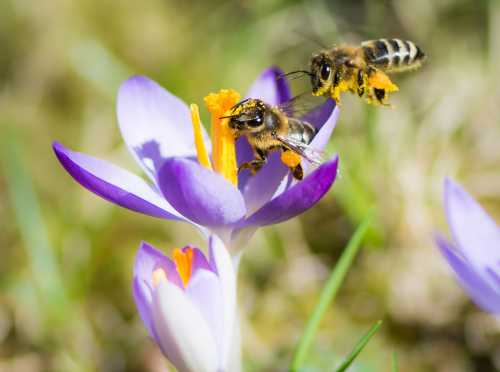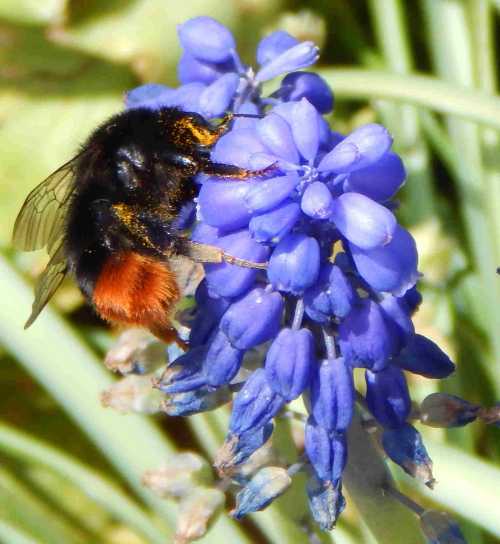7 Of The Best Crocuses For Honey Bees, Bumble And Solitary Bees
I love crocus flowers, and if you are looking for an early spring flower for bees, crocuses are a great choice. That said, autumn flowering crocuses are available.
Crocuses can be grown in pots, in the border, or in my view, one of the best places to see them: in the lawn.
Why Do Bees Like Crocus Flowers?
Careful selection of your crocus varieties could enable you to provide food from autumn through to late winter or early spring. As well as nectar, crocuses provide hungry bees with plenty of pollen.
Honey bees
Honey bees certainly visit crocus flowers. Those that flower in late winter to early spring will provided much needed sustenance to foraging worker honey bees, keen to replenish the colony food stores following the cool winter months.
It's worth remembering that honey bees will brave very cool temperatures in order to find food for the colony.
 Honey bees visiting crocus flowers
Honey bees visiting crocus flowersBumble bees
New generations of bumble bee queens will particularly benefit from the crocus pollen they gather from autumn flowering varieties. These new queens need to consume a fair amount of pollen in order to lay down fat reserves for their winter snooze.
Then later, when the same new queens emerge from hibernation, the crocus nectar will provide energy, whilst the pollen is an important source of protein and lipids (fats)1, and will help her ovaries develop, and may also be used to feed her offspring.
Solitary bees
Crocuses also help to feed solitary bees.
From early spring, a number of solitary bee species will emerge and begin the process of creating nest cells that will be provisioned primarily with pollen to feed emerging larvae.
 Tawny mining bee emerge in spring - here a female visiting a crocus
Tawny mining bee emerge in spring - here a female visiting a crocusWhich Crocuses Are Best For Honey Bees, Bumble Bees And Solitary Bees?
As far as I am aware, pretty much all of the crocuses provide food for bees, but I tend to prefer to select for early spring flowering.
I can especially recommend the following:
1. 'Vanguard'
A lovely mauve crocus, with orange styles. Flowers from February - in my view, this makes it one of the best crocuses for bees.
2. Crocus tommasinianus –
Early crocus, 'Whitewell Purple'
This crocus has
slender purple petals and orange stamens. It will flower from late winter to early spring, and is helpful for early foraging bees.
Highly recommended for inclusion in your winter border for bees.
3. Yellow Giant - 'Golden Yellow'
Produces large yellow flowers in spring from February to March.
 Honey bees foraging on 'Golden Yellow' crocus
Honey bees foraging on 'Golden Yellow' crocus4. Goldilocks
Another pretty, spring-flowering yellow crocus.
5. 'Ruby Giant'
Stunning, rich purple flowers and with an orange
stigma.
 Bumble bee peeping out of a crocus flower
Bumble bee peeping out of a crocus flower
6. Joan
of Arc
I love to see white crocus flowers peeping out between evergreen shrubs. Joan of Arc has large white flowers with purple at the base. The stigma is orange and
frilly.
7. Autumn flowering crocus - Crocus speciosus
A pale mauvish, lilac crocus with dark veins.
This crocus flowers from September to November and provides late foraging bees with an additional food source.
 New queen foraging on Crocus speciosus
New queen foraging on Crocus speciosusAs discussed above, a late protein source is especially beneficial to the new generation of queen bumble bees needing to build up fat reserves to survive the winter.
So, if you have space on a sunny lawn, or a few pots going spare, why not include some in your garden?
Do Bees Like Saffron Crocus?
Yes, bees also visit the saffron crocus, Crocus sativus, which flowers in autumn.
 Honey bee foraging on saffron crocus
Honey bee foraging on saffron crocus
It is of course possible to harvest the delicate strands of saffron from these flowers, which can then be dried.
How To Plant Crocuses For Bees
Crocuses are versatile, and look great in a variety of garden settings.
- Naturalized in lawns
If planting in a lawn, then arrange them in informal drifts, and remember that it's best not to mow the lawn until the leaves have died back after the crocuses have flowered. - Pots, window boxes, containers, hanging baskets
Crocuses look great on their own or as part of a mixed plant arrangement in a variety of containers. - Underplanting
Shrubs can be underplanted with crocuses, adding interest and brightening up otherwise shady spots, especially around evergreens.
You can divide clumps of bulbs (actually corms) and plant elsewhere in the garden.
Also, see: Do Bees Like Snowdrops?
References
1. Vaudo AD, Tooker JF, Patch HM, Biddinger DJ, Coccia M, Crone MK, Fiely M, Francis JS, Hines HM, Hodges M, Jackson SW, Michez D, Mu J, Russo L, Safari M, Treanore ED, Vanderplanck M, Yip E, Leonard AS, Grozinger CM. Pollen Protein: Lipid Macronutrient Ratios May Guide Broad Patterns of Bee Species Floral Preferences. Insects. 2020 Feb 18;11(2):132. doi: 10.3390/insects11020132. PMID: 32085627; PMCID: PMC7074338.



